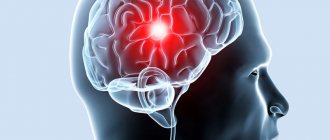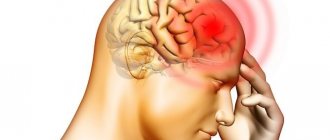Hallervorden-Spatz disease (progressive rigidity) is a rare hereditary neurodegenerative disease that affects the basal ganglia and accumulates iron in them.
Cumulative processes occur in the substantia nigra and globus pallidus. Also in the cerebral cortex, changes in nerve cells are observed, the appearance of pigmented neuroglia, and glial cells similar to glia in Alzheimer's disease.
The disease was first described by German researchers Julius Hallervorden and Hugo Spatz, after whom it was named.
However, in modern international medical practice, the disease is called neurodegeneration with brain iron deposition (NBIA). The abandonment of the original name is due to the fact that Julius Hallervorden conducted research on euthanasia in Nazi Germany.
The disease is considered rare, with up to 3 people having the disease per 1 million people. This neurodegeneration can lead to parkinsonism, dystonia, dementia, and death.
general information
The basal ganglia are neural subcortical ganglia located in the central white matter of the hemispheres. They consist of the striatum, striatum and lenticular nucleus. The structure of the latter includes the globus pallidus and the shell. In addition, part of the substantia nigra, a part of the extrapyramidal system, belongs to the basal ganglia.
Purpose of the basal ganglia:
- regulation of motor and autonomic functions (breathing, cardiovascular system);
- participation in integrative processes of higher nervous activity.
With Hallervorden-Spatz disease, iron accumulates in the globus pallidus and substantia nigra, which leads to disruption of their function. As a result, motor dysfunctions and mental disorders occur. The disease was first described in 1922 by physicians Julius Hallervorden and Hugo Spatz. It occurs in 3 out of 1,000,000 people.
Treatment of Hallervorden-Spatz disease
Currently, no effective treatments have been developed for Hallervorden-Spatz disease. In this regard, symptomatic treatment is used. Parkinsonism syndrome is an indication for the use of dopamine agonists or amantadine derivatives. However, with this disease, it is usually resistant to treatment.
For hyperkinesis, the use of valproates and benzodiazepines is indicated. For spastic symptoms, muscle relaxants are recommended, for epileptic seizures - topiramate or valproate, for cognitive disorders - ipidacrine and choline alfoscerate, for mental disorders - antipsychotics.
Treatment of patients with Hallervorden-Spatz disease remains mainly symptomatic, that is, aimed at relieving symptoms rather than eliminating the cause. It is currently not possible to eliminate the genetic abnormality that leads to HSP.
Tremor is effectively treated with dopaminergic agents. The anticholinergic drug benzotropine can be used to alleviate muscle stiffness and tremors, as well as dopamine agonists.
To eliminate dysarthria and drooling, the following are recommended:
- methscopolamine bromide;
- speech therapy manipulations.
Systemic chelating agents such as desferrioxamine have previously been used to remove excess iron from the brain, but their effectiveness has not been proven. Dementia is a progressive symptom and its progression can be slowed, but the condition cannot be cured.
Recommended medications for Hallervorden-Spatz disease:
- baclofen;
- benztropine;
- memantine;
- rivastigmine;
- donepezil.
Recommended activities:
- physiotherapy;
- occupational therapy;
- speech therapy.
There is currently no cure for Hallervorden-Spatz disease. Previously, they tried to influence the accumulation of iron in the cells of the basal ganglia. However, this treatment regimen did not prove effective.
Research is underway on drugs belonging to the group of detoxifying agents. It is assumed that they are able to slow down the progression of HSP. Clinical trials have shown that this is indeed the case, but the difference is not significant.
To alleviate the patient's condition, symptomatic medications are used.
- Treatment of parkinsonism. Dopamine agonists alleviate symptoms, but they are significantly less effective in HSP. Therefore, tranquilizers are more often prescribed for hyperkinesis.
- For muscular dystonia, muscle relaxants are used.
- For epileptic seizures - antiepileptic drugs of the valproate group.
- For signs of severe mental disorders - antidepressants and antipsychotics.
Therapy helps improve the course of the disease and alleviate the main symptoms. However, taking medications does not affect life expectancy in any way and does not improve the prognosis.
https://www.youtube.com/watch?v=https:accounts.google.comServiceLogin
Experimental tools are being developed. These include experimental surgical treatment methods: pallidotomy and thalamotomy. However, most patients who undergo surgery return to the original level of manifestations within a year after surgery.
Generally unfavorable, as the disease is incurable. The timing of the onset of disability depends on the clinical form of the disease. The most favorable prognosis is with a late onset of the disease. In this case, dementia is mild, symptoms progress slowly.
With early manifestation, manifestations are stable and progress quickly. Complete loss of the ability to self-care occurs 10 years after the onset of the disease.
Do not neglect treatment. It improves the patient’s quality of life and makes it possible to delay the moment of disability.
Causes and pathogenesis
Hallervorden-Spatz disease is a hereditary pathology: it is transmitted according to an autosomal recessive principle. However, the medical literature describes not only familial cases of the disease, but also sporadic (random) cases.
The cause of the disease is mutations in the PANK2 gene, located on chromosome 20. It is responsible for encoding pantothenate kinase. This enzyme is involved in the biosynthesis of coenzyme A, which accelerates the phosphorylation of pantothenate, panthine and N-pantothenylcysteine.
A genetic defect leads to decreased production of pantothenate kinase. As a result, the amino acid cysteine accumulates in the basal ganglia, which has the ability to bind iron ions. As a result, stable compounds are formed in the brain, provoking the destruction of neuronal proteins.
Apoptosis (death) of neurons is enhanced by oxidative reactions involving free radicals. As a result, the destroyed neurons are replaced by glia - auxiliary cells of the nervous tissue.
The pathological picture of Hallervorden-Spatz disease is characterized by such signs as:
- accumulation of pigment containing iron in the globus pallidus, substantia nigra and red nuclei, causing these areas to acquire a yellowish-brown tint;
- neuroaxonal formations (axons with local extensions) in the basal ganglia, cerebral cortex and peripheral nerves;
- death of neurons in different parts of the brain;
- diffuse demyelination - destruction of the sheath of nerve fibers.
The general metabolism of iron is not impaired - its amount in the blood serum does not exceed the norm.
Symptoms
Depending on the age at which symptoms appear, three variants of Hallerwarden-Spatz disease are distinguished:
- infantile – manifestation at 1-3 years;
- typical child - 4-15 years;
- late – 16-20 years and older.
There is another classification:
- children's form - debut at 4-10 years;
- juvenile – 10-18 years;
- adult (atypical) – after 18 years.
The pathology is characterized by polymorphism of symptoms. In most cases, it appears after 5 years. Typical signs of the child form:
- dystonia of the lower extremities - muscle contraction leading to changes in gait;
- generalization of movement disorders - the muscles of the trunk, face, and pharynx are gradually involved in the process, with torticollis, spasm of the hands, blepharospasm, and so on observed;
- parkinsonism syndrome, which is accompanied by hypokinesia, muscle rigidity and tremor at rest;
- epileptic seizures;
- visual disorders – retinal degeneration, optic nerve atrophy;
- mental retardation as a result of deterioration of attention and memory;
- aggressiveness, asociality.
The juvenile form is characterized by dystonia of the muscles of the limbs and maxillo-oral region, as well as neuropsychological and behavioral disorders.
The atypical variant of Hallervorden-Spatz disease, which debuts after 18-20 years, is rare - in 15% of cases. It is accompanied by symptoms such as:
- parkinsonism syndrome with postural instability - inability to maintain balance;
- hyperkinesis in the form of dystonia, choreoathetosis (a combination of jerky and slow movements), hemiballismus (sweeping movements on one side of the body), myoclonus (short-term muscle spasms);
- dementia – persistent decline in intellectual abilities;
- pyramidal signs are pathological reflexes that arise due to damage to brain neurons.
Forms of pathology
Hallerwarden-Spatz syndrome has three forms. The division is based on the age at which the disease begins to develop:
- Children's uniform . The onset of the disease occurs before the age of 10 years.
- Juvenile (teenage) form . The disease develops between 10 and 18 years of age.
- Adult (atypical) form . The disease manifests itself after 18 years of age.
Article on the topic: Elevated lymphocytes in blood tests in children and adults - causes of deviations, consequences and methods of treatment
Diagnostics
Hallervorden-Spatz disease is diagnosed based on clinical symptoms, which are established during a neurological examination. In addition, a genetic test showing a mutation in the PANK2 gene and magnetic resonance imaging of the brain are performed.
MRI demonstrates:
- “eye of the tiger” is an oval, symmetrical hyperintense area within the hypointense zone in the area of the globus pallidus, which occurs due to the accumulation of iron in some cells and the destruction of others;
- spheroid neuroaxonal formations in the basal ganglia.
Positron emission tomography shows decreased blood flow in the striatum, globus pallidus, and frontoparietal lobes.
Hallervorden-Spatz disease is differentiated from Wilson-Konovalov disease and neuroacanthocytosis.
Treatment
Treatment for Hallervorden-Spatz disease is aimed at relieving symptoms. There is no therapy that can affect the cause of the pathology.
Basic medications:
- deferoxamine, ferriprox are iron chelators that are able to form chemical bonds with it and prevent its accumulation, but for the disease in question they are ineffective;
- Levodopa is an antiparkinsonian drug;
- anticholinergics to reduce the severity of hyperkinesis;
- baclofen, benzodiazepines, muscle relaxants and diaspora injections to relax muscles and relieve pain;
- neuromidin and gliatilin for the correction of cognitive impairment;
- atypical antipsychotics for the treatment of mental disorders.
The newest treatments for Hallervorden-Spatz disease include pantothenic acid administration and magnetic brain stimulation.
How can modern doctors help?
There are no treatments in modern medicine that can prevent or stop Hallervorden-Spatz disease.
Therapy is aimed at alleviating and relieving the intensity of symptoms:
- For parkinsonism syndrome, dopamine agonists (Pronoran, Pramipexole, Mirapex, Piribedil) and amantadines (Simmetrel, Midantan) are prescribed. However, the syndrome is often resistant to treatment.
- To relieve hyperkinesis, valproates (Konvulex, Depakin, Encorat) and benzodiazepines (Clonazepam, Diazepam) are used.
- To relieve muscle spasticity, muscle relaxants (Mydocalm, Baclofen) are used.
- Epileptic seizures are relieved with valproate , Tomapax.
- For cognitive impairment, Gliatilin and Neuromidin .
- For the treatment of mental disorders, it is recommended to take antipsychotics (Clonazepam, Quetiapine, Rispolent), antidepressants (Dapoxetine, Citalopram, Venlafaxine).
New methods of treating the disease are also emerging. These include therapy by administering pantothenic acid, magnetic stimulation of the brain (globus pallidus).
Forecast
Hallervorden-Spatz disease is characterized by a steady progression of symptoms. The most aggressive course is characteristic of the childhood form: 6-15 years after the onset of the pathology, complete disability occurs.
The late version of the disease has a more favorable prognosis, especially if accompanied by mild dementia. Through therapy, the severity of symptoms can be reduced and the patient's ability to self-care can be maintained. The average duration of the atypical form of the disease is 20 years or more.











